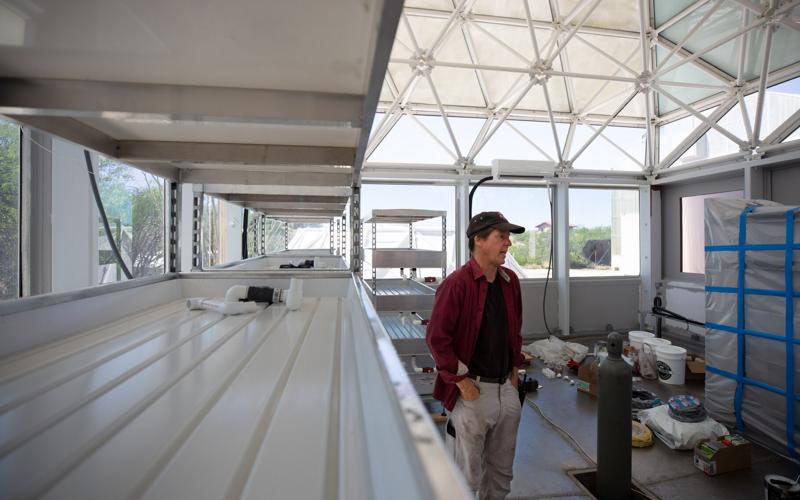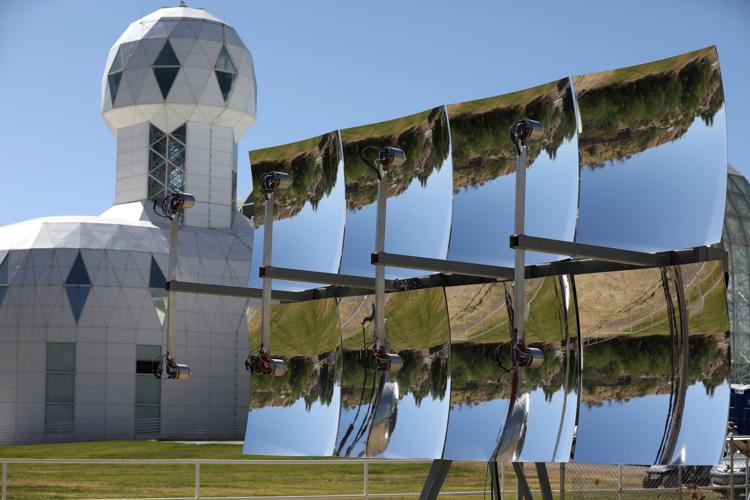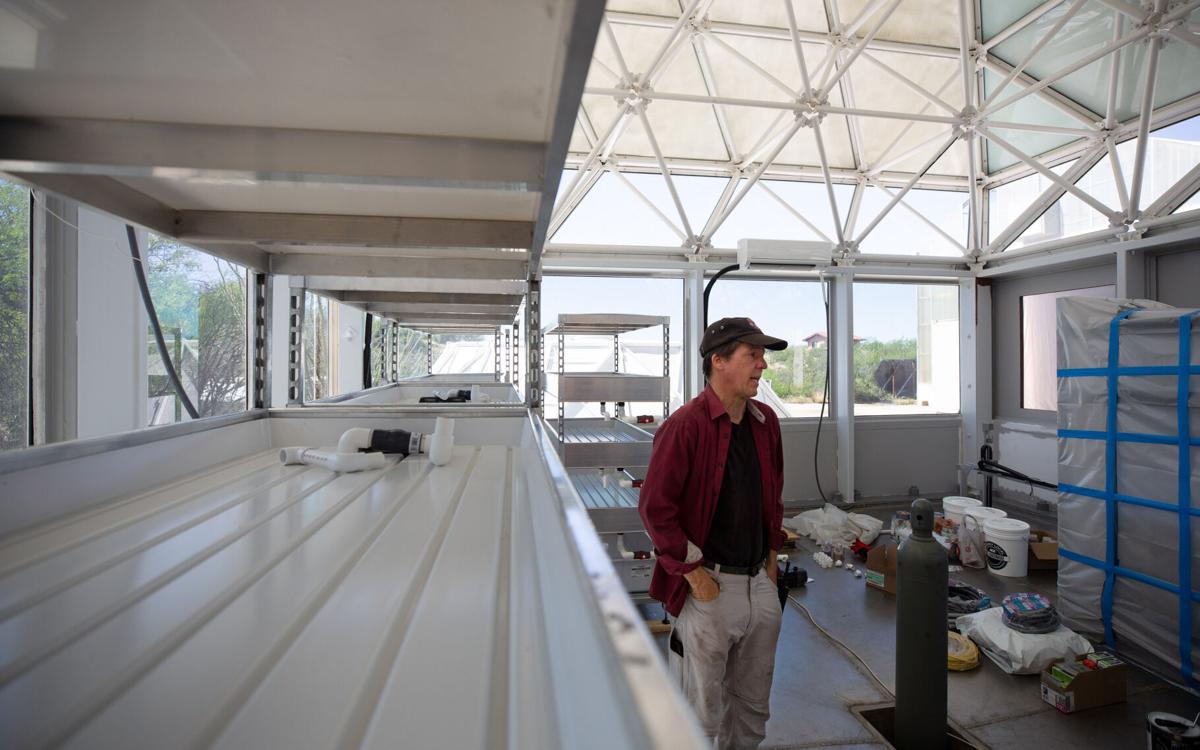University of Arizona’s Biosphere 2 has been the site for research on ecological systems and human habitation since it was built in the late 1980s.
Now, the 3-acre ecological laboratory about 30 miles north of Tucson near Oracle is providing fertile ground to help grow startup companies focused on renewable energy and sustainable technology.
The UA Center for Innovation recently launched its latest business incubator “outpost” at Biosphere 2, with an inaugural class of four startup companies:
Over the Sun, an Arizona-based company that produces platforms for research, science outreach and education and is building a Mars habitat at Biosphere 2
SolarSpace, a Tucson-based startup using licensed UA solar technology for off-grid applications including electric vehicle charging stations
Tectonicus Constructs, a local architectural firm developing a unique “solar river” concept of covering miles of canals with photovoltaic panels
Red Sea Farms, a Saudi Arabia-based company developing sustainable agriculture technologies for harsh environments
The Biosphere 2 startups will go through the UACI’s structured, 27-point “roadmap” that provides a continuum of education provided by mentors, advisors and community collaborators, while using the center’s various physical spaces — now including Biosphere 2.
The Biosphere 2 outpost is the fourth for UACI, a UA-sponsored business incubator that has significantly expanded its scope and footprint in the past few years.
While maintaining its base at the UA Tech Park on South Rita Road, the UACI has established outpost incubators with local partners in Oro Valley, Sahuarita and Vail, and now counts more than 70 startup members.
It’s all part of the UACI’s concept of developing a “village” to support tech startups across Tucson and Southern Arizona with programs that can easily be extended and scaled across the region with local partners, said Eric Smith, executive director of the UACI.
“The Biosphere 2 is in full support of our mission to really bring together this village, and see the village as more than Tucson,” Smith said.
It has not been hard to bring on partners such as the towns of Oro Valley and Sahuarita, he noted.
“Anytime we’ve expanded into a region, it’s not because we said we wanted to — there’s always been a pull from that region, and it shows there’s a need for that,” Smith said. “So there’s a need, but they don’t necessarily have the skill set to build the space or run the program.”
While the startups at Biosphere 2 are using the site’s unique assets to further their technologies, the new UACI center there — built in a space partway up the Biosphere 2’s distinctive geodesic-dome-topped tower in a space once used as a press room for visiting journalists — gives them desk space to conduct business while interacting with fellow UACI startups.
“We’ve built what we would consider the watercooler, some place for them outside of their technical and scientific work spaces to sit down and work on their IP (intellectual property) and connect with each other and have meetings,” Smith said.
Two of the four UACI members at Biosphere 2 already have begun using space there.
SolarSpace uses concentrating solar technology licensed from the UA and invented by UA astronomer and Regents Professor Roger Angel, which uses a system of mirrors or sun-tracking mounts to focus sunlight on high-efficiency photovoltaic cells.
The company was founded in 2020 by entrepreneur David Vili, who acquired the assets of a company Angel formed to commercialize his technology.
SolarSpace inherited a system Angel’s former company had been testing at Biosphere 2 and is setting up additional systems for testing there.
Meanwhile, since last year, Over the Sun has been converting an on-site Biosphere 2 prototype used for small-scale testing before the main buildings were constructed into a simulated human habitat for the moon or Mars.
Here’s a closer look at the four inaugural startups at the UACI-Biosphere 2:

The shipping container on the left has been retrofitted as a hermetically sealed living space, attached to the existing test module, built in 1987, at the Space Analog for Mars and Moon site under construction at Biosphere 2 near Oracle.
Over the Sun
Founded by Kai Staats, a Benson-based researcher, filmmaker and entrepreneur, Over the Sun LLC has produced science documentary films and has developed a computational model and educational interface to study the challenges of off-world, human habitation.
The habitat the company is building at Biosphere 2, known as the Space Analog for Moon and Mars (or SAM), is a hermetically sealed environment for short- and long-term biology, ecology, chemistry and habitation studies.
The artificial habitat will include a greenhouse, living quarters, airlock, pressure suits, and a half-acre “Mars yard” simulating the Martian environment.
Staats, who also holds a part-time position with the UA, was busy with his crew this week, preparing to marry two shipping containers with the part of the original Biosphere 2 prototype lab.
Once the habitat is finished by early next year, the plan is to bring teams of students or researchers in for stays ranging from a few days to a few months, said Staats, who received an undergrad degree in industrial design from Arizona State University in 1993 and a master’s in machine learning from the University of Capetown, South Africa.
At Arizona State University, Staats led the development of SIMOC (Scalable, Interactive Model of an Off-World Community), a research-grade computer simulation and educational interface to a Mars habitat, hosted by National Geographic for free use by schools and citizen scientists.
Staats came to Biosphere 2 in 2019 to build his own dataset for plant growth, as his focus shifted to more self-sustaining, plant-based human support systems from mechanical-based systems now used in environments such as the International Space Station.
“This simulator is simulating mechanical systems and plant-based systems, and you can design it to do a crossover between the two, so as the plants become more mature and grow up, they’re taking in more CO2 (carbon dioxide) and producing more oxygen, so we rely less and less on the mechanical-based systems,” he said. “That model is built on 40 years of NASA data, and it’s all real data.”
Staats said he came Biosphere 2 to add his own research to that dataset and fell in love with the campus.
Part of what Over the Sun hopes to accomplish with UACI is to develop a business model to get the SIMOC model in thousands of schools worldwide.
“This (Space Analog for Moon and Mars) is the physical representation of that digital system, and when finished it will be an actual, functioning pressure vessel, where people will stay inside for anywhere from five days to months at time,” he said.
Staats says there are 10 research-grade human habitats — known as “analogs” — worldwide, including four funded by NASA, but SAM will be the only one to be hermetically sealed, much like the original Biosphere 2.
The test module that Over the Sun is adapting for its habitat was originally built in 1987 as the second prototype for Biosphere 2.
“When you seal it up, and you’re completely recycling the air and water, and you’re trying to grow as much of your food as you can, it completely changes the game,” he said. “It makes it really, really close to what it would be like to be living on Mars, so we’re coming back to the origin of what Biosphere 2 was originally built for.”

SolarSpace, a Tucson-based startup, is using licensed UA solar technology for off-grid applications including electric vehicle charging stations at the UA Center for Innovation at Biosphere 2.
SolarSpace
SolarSpace landed at the UACI last fall after winning membership in a “sponsored launch” funded by the town of Sahuarita and copper giant Freeport McMoRan.
SolarSpace is led by Vili, a longtime entrepreneur and native of the nation of Georgia in Eastern Europe, who while on a pilgrimage to a monastery in Arizona came across a demo version of Angel’s solar tracker at the UA’s Biosphere 2 during a UA event there.
He bought a system for the St. Anthony’s Greek Orthodox Monastery in Florence and later founded SolarSpace to acquire the assets of Angel’s company and is initially marketing the technology to power stand-alone EV chargers in off-grid areas.
Vili said the company is now working on a new, complementary technology to make use of the intense heat generated by the sunlight-concentrating mirror system.
The company has licensed from NASA a technology that turns heat into sound waves that can then be used to generate electricity, Vili said.
“The hotter it gets, the more efficient it gets,” Vili said.
The company also is working with NASA to develop a system to use electricity to generate hydrogen, which can be stored and converted back to electricity, as an alternative to lithium-ion batteries now used for energy storage, Vili said, noting that the hydrogen could also be used to refuel vehicles operated on hydrogen-based fuel cells.
Vili said he hopes to initially work with partners including Native American tribes, automakers and existing fuel stations to set up solar EV chargers in off-grid areas — especially tribal lands.
“They are so far off the grid, the technology revolution is going to leave them behind,” he said.

Employees of Red Sea Farms work within the University of Arizona Center for Innovation at Biosphere 2. The Saudi Arabia-based company is developing sustainable agriculture technologies for harsh environments.
Red Sea Farms
Saudi-based Red Sea Farms is developing systems to grow crops in the harshest of climates — including with salty or brackish water.
In 2019, Red Sea Farms secured a $1.9 million co-investment from the King Abdullah University of Science and Technology Innovation Fund and Research Products Development Company and is using it to build a 2,000-square-meter pilot saltwater greenhouse on the university campus in Thuwal, Saudi Arabia.
The company says its saltwater greenhouses can replace up to 90% of freshwater inputs with saltwater.
“We chose the UACI and Biosphere 2 for a US base because of the synergies in vision, the location in Tucson, and the great support offered for international businesses like ours to enter the North American market,” said Ryan Lefers, co-founder and CEO of Red Sea Farms.
Red Sea Farms staffers are currently using the new UACI office to design the company’s planned greenhouse project at Biosphere 2.
“We hope to demonstrate the game-changing nature of our technologies in cooperation with Biosphere 2 and the Controlled Environment Agriculture Center at UA, to enable sustainable and productive agriculture in water-scarce and harsh climates, leading to rapid company growth and adoption of our technologies on a large scale both in the USA and globally,” Lefers said in an email.

This conceptual rendering of a Solar River project by Tectonicus Constructs LLC shows photovoltaic panels placed over an irrigation canal. The water from the canal cools the undersides of the panels, increasing their efficiency; the panels reduce evaporation.
Tectonicus
Tectonicus Constructs says its Solar River system of placing photovoltaic panels on the top of canals can save valuable farmland and wilderness by using available canal space, while cooling the solar panels for higher efficiency and reducing evaporation from canals.

While the startups at Biosphere 2 are using the site’s unique assets to further their technologies, the new UACI center there — built in a space partway up the Biosphere 2’s distinctive geodesic-dome-topped tower in a space once used as a press room for visiting journalists — gives them desk space to conduct business while interacting with fellow UACI startups.
Coal, natural-gas, and thermo-electric power plants are the largest industrial consumer of water in the West, Tectonicus founder Ben Lepley said.
The company’s technology is based on the work of Lepley, an architect and former instructor at the UA School of Architecture who has developed the Solar River concept under a U.S. Department of Energy grant awarded in 2019.
The Solar River project is a new venture for Tectonicus, which has been providing architectural and design services with a focus on sustainability since 2012.
Tectonicus has proposed building a Solar River demonstration project on a roughly 1,000-foot-long expanse of canal along Interstate 10 for the Gila River Indian Community so they can power their irrigation system with renewable energy.
Tectonicus has built three concrete canals at Biosphere 2 as the foundation for a system to test its Solar River concept of covering canals with solar panels.










